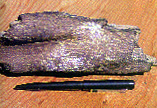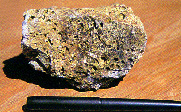作者:安德鲁•斯奈林(Andrew Snelling)翻译: 中国创造论团契
1993年,在昆士兰中部的新文殊兰煤矿(Crinum Coal Mine,见下方地图),煤矿工人建造通风井时有发现了一个罕见的现象。挖开沙和粘土的薄层,穿过玄武岩层,在距离地面21米(大约69英尺)深的地方,他们发现了一些被埋在玄武岩底层的木材。 1
玄武岩层以下有粘土岩、粉砂岩和夹有煤层的砂岩2。
在玄武岩层中的“古老”木化石
在玄武岩层中发现的木材有三种状态:灰烬、碳化的和完整的1 。当时在现场的人推测,被发现的木材来自两棵不同的树,部分保持直立姿势,仍含有机质,所以并非化石。在玄武岩层中还发现了一片树叶的拓印,这个发现也是 非常惊人的,毕竟包裹这些木头和树叶的岩层曾经是熔岩,喷发时温度大约在1000-1200°C(约1800-2200°F) 。
那么这些树干在被熔岩吞噬后是怎么幸存下来呢? 4米(13英尺)厚的玄武岩流相对来讲比较薄,1 , 3因此熔岩的冷却速度会很快(也许几天,最多不超过几周4)。这个推断可以通过对玄武岩层内部结构的观察得到证实。 1,5树干被熔岩流覆盖时位于其底层,那里的熔岩可能是立即冷却的,存于树干中的水份也会有助于迅速的包裹,因而得到了保护。
从周边地区的地质环境判断,该玄武岩流大约是在“3千万年前”形成的, 1 ,3为要与这个地区其它玄武岩流的年代保持一致,它们被认定属于(传统术语的)“第三纪”。因为树干被埋在玄武岩熔流中,所以这木材至少应该有3千万年了。同时,在这片玄武岩层以下的粉砂岩层中,也发现了类似树根的物质,3
表明这些树在存活的时候植根于粉砂岩中,就是说当时的生长地被玄武熔岩覆盖了(附近发生火山爆发)。这一层粉砂岩属于二叠纪德国溪(German Creek)煤层,按照传统的观点,它的年龄约为2.55亿年。 6
采集样本
我们收到了少量的这些木材的碎屑样品,随后在1994年8月下旬访问了那个煤矿。 7我 们检查了煤矿工人所发现的树木化石和带有树叶印痕的岩石,并拍了照片,但不能进入(发现树木化石的)通风井,也未能取得包裹树木化石的玄武岩样本,因为它 们早已和其它废石一起被扔掉了。然而,在(发现树木化石的)通风井附近他们又钻了一个勘探孔。在玄武岩层的底部,就在玄武岩流与下面的粉砂岩的交界 处,岩芯内发现了被玄武岩包裹着的含有机碳的树木化石碎片。在得到煤矿公司的许可之后,这个钻孔的岩芯随后被寄给了我们。 7
在造访了煤矿之后,我们还对附近同一个玄武岩流形成的地面岩石进行了调查和采样。这是为了确保如果煤矿公司不给我们岩芯,我们至少还有一些玄武岩的样品。
 碳化的树木化石 |
 保留原状的树木化石 |
 (由于熔岩中的气泡而造成的)带孔玄武岩 |
 在粉砂岩中的树与根的化石 |
我们从钻孔岩芯中被玄武岩包裹的树木化石碎片中,取了两份微量样品,送到两个著名的实验室进行放射性碳(碳-14)分析。这两个实验室分别是在波士顿(美 国)剑桥的地质纪(Geochron)实验室,以及在澳大利亚悉尼附近卢卡斯山庄(Lucas Heights)的澳大利亚核科技组织(ANSTO)的安塔勒斯质谱( Antares Mass Spectrometry)实验室。为确保检测结果不受成见的影响,样品送检时并没有向这两个实验室透露样品的来源。两个实验室使用了灵敏度高的加速器质 谱法(AMS)对样品进行放射性碳分析。地质纪实验室是商业实验室,而安塔勒斯实验室是一个重点研究实验室。我们将最初寄来的在建造通风井时发现的树木化 石的微量碎片也送到这两个实验室,进行放射性碳分析。
我们也同样把露出地面的玄武岩石和钻孔岩芯样本送交实验室分析,对送检的岩石进行主要元素、次要元素和微量元素分析,以确定这些岩石的性质,但主要是进行 放射性“测年法”的分析。在澳大利亚的阿姆德莱(AMDEL)实验室对露出地面的两个玄武岩样品进行了钾-氩(K-Ar)“测年法”分析;而两个露出地面 的玄武岩样品中的一个,以及两个岩芯样品(其中一个是与树木化石接触的岩石样品),送去地质纪实验室进行“测年法”分析。
测试结果
放射性碳(碳-14)测年法的结果如表1示。 8很显然,所有的树木化石中都可以检测到放射性碳,所以实验室的工作人员毫不迟疑地、轻而易举地计算出了树木化石的碳-14“年龄”。之后,当我们问及放射性碳分析法的使用范围以及样品受到污染的可能性时,两个实验室的工作人员(博士科学家),9对大部分结果(的可靠性)非常有把握,认为(树木化石的放射性碳)在可测范围内,所以测定结果提供了有引用价值的有限“年龄”,只有一个实验室对一个样本没有把握。 8 此外,他们指出几个树木化石样本中的δ13C检测结果是几乎一样的(见表1最后一列),表明碳元素来自木材中的有机碳,提示不存在污染的可能性。因此提供 报告的实验室坚定地表示表1中的分析结果是真确有效的,岩芯中埋藏在玄武岩中的树木化石的“年龄”大约是44000-45500年。
使用钾-氩(K-Ar)测年法得到的玄武岩“年龄”(见如表2< /a>)8树 木化石的年龄形成鲜明对比。 8从两家实验室提供的第二个露出岩石样本年龄,可见测定结果的差异很大。要测得一致的、“可接受的”钾-氩“年龄”成了一个问题,因为两个露出岩石样品和 两个岩芯样品可能代表同一个玄武岩流的不同位置,(因此才有了表2最后一列算出的平均年龄)。 10两个实验室的工作人员(同样是博士科学家)都坚持他们的分析结果是可靠的,8,11并且毫不犹豫地肯定,根据放射性钾-氩“测年法”的分析结果,这些玄武岩样品的年龄约为4500万年。
|
所有参与此工作的实验室所提供的分析,其质量和准确性无疑是值得尊重的,但是所计算出来的“年龄”仅仅是基于一些未经证实的假设:假设放射性衰变的速率恒 定,而且这些元素(及其同位素)在无法观测到的过去,其地质化学特性都是恒定不变的。对于持有年轻地球观点的创造论者而言,这些被埋藏在玄武岩中的树木化 石在地质学意义上显然代表了一些后洪水时期的树木,在挪亚洪水后它们被附近的火山喷发出的熔岩所掩埋,因而这些树木化石和玄武岩年龄都不到4500年。 12
然而,在传统的(均变论的)解释框架下,这两种放射性“测年”结果之间存在明显的矛盾。通常在这样一个“古老”的玄武岩层中发现的树木化石,是不会被拿来用放射性碳进行“测年”的,因为树木化石会被认为太古老,以致其内部不会存在任何放射性碳(全部衰变了)。 13这件事再次证实了这些放射性“测年法”是不可靠的,对于鉴定树木化石和玄武岩的真实年龄显然是无用的。 14 因此,任何从这些“测年法”所得到的结果,均不应用以质疑圣经纪年的可靠性,圣经的记述是(自有永有的)创造者自己向我们详细启示的。
|
|||||||||||||||||||||||||||||||
参考文献和备注
- 'Rare find unearthed at Crinum', BHP Australia Coal Newsline, p. 1, December 1993–January 1994. 回到内文
- 地质岩层截面图和钻孔相关的分析数据由“殊兰煤矿项目”工作人员慷慨提供。 回到内文
- “殊兰煤矿项目”的总工程师格雷格•B•查尔默斯(Greg B. Chalmers)1994年4月27日来函。 回到内文
- AA Snelling, The formation and cooling of dykes, Journal of Creation 5(1):81-90, 1991. 回到内文
- (玄武岩)上层充满了空泡(由于熔岩中带有的气泡而造成球形洞),中层颗粒粗糙,底层坚硬、致密、颗粒纤细,显示自下向上和自上向下同时快速冷却。 回到内文
- Falkner, 'Sedimentological studies in the German Creek coal measures and their relevance to longwall mining', New Developments in Coal Geology (A Symposium) , JW Beetson (ed.), Coal Geology Group (Geological Society of Australia), pp. 143–148, 1993. 回到内文
- Greg B. Chalmers, then Chief Project Engineer, and BHP Australia Coal Pty Ltd, operators of the Crinum Mine, are thanked for allowing our visit to the mine and the photographing of their fossil wood and leaf specimens, and for providing pieces of their fossil wood samples and the several metres of drill core that were so crucial to this investigation. 回到内文< /li>
- Original copies of all the official laboratory analytical and 'dating' reports, and the correspondence with staff of the laboratories, have been kept on file. 回到内文
- The one exception was due to the small quantity of carbon extracted from the sample, but when repeated by the other lab, a finite 'age' was obtained. 回到内文
- However, other analytical results provide evidence that the outcrop does probably represent a younger, though closely related, basalt flow to that sampled in the drill core. 回到内文
- They did suggest the possibility of some variable contamination of the samples with atmospheric argon, but definitely not contamination introduced by their laboratory procedures. 回到内文
- It needs to be remembered that during the Flood and immediate post-Flood periods the earth's stronger, but fluctuating, magnetic field affected the incoming cosmic ray influx, resulting thus in a lower radiocarbon production rate and therefore radiocarbon 'ages' much greater than the true ages. 回到内文
- The results of this investigation confirm that it is likely radiocarbon may also be detected in other fossil woods found at even deeper levels in the so-called geological column, even if the fossil wood was from pre-Flood trees buried during the Flood. Further investigations are in progress. 回到内文
- A fuller report with all technical and analytical details, including the results from other radioactive 'dating' methods and the attempted identification of the fossil wood, was later published, Latest Technical Journal (vol. 14 no. 2) rebuts skeptics, 2000. 回到内文
- δ13CPDB denotes the measured difference of the ratio of 13C/12C (both stable isotopes) in the sample compared to the PDB (Pee Dee Belemnite) standard—a fossil belemnite from the Cretaceous Pee Dee Formation in South Carolina, USA. The units used are parts per thousand, written as ‰ or per mil (compared with parts per hundred, written as % or per cent). Organic carbon from the different varieties of life gives different characteristic δ13CPDB values. 回到內文
'Rare find unearthed at Crinum', BHP Australia Coal Newsline, p. 1, December 1993–January 1994.
“殊兰煤矿项目”的总工程师格雷格•B•查尔默斯(Greg B. Chalmers)1994年4月27日来函。
AA Snelling, The formation and cooling of dykes,
(玄武岩)上层充满了空泡(由于熔岩中带有的气泡而造成球形洞),中层颗粒粗糙,底层坚硬、致密、颗粒纤细,显示自下向上和自上向下同时快速冷却。
Falkner, 'Sedimentological studies in the German Creek coal measures and their relevance to longwall mining', New Developments in Coal Geology (A Symposium) , JW Beetson (ed.), Coal Geology Group (Geological Society of Australia), pp. 143–148, 1993.
Greg B. Chalmers, then Chief Project Engineer, and BHP Australia Coal Pty Ltd, operators of the Crinum Mine, are thanked for allowing our visit to the mine and the photographing of their fossil wood and leaf specimens, and for providing pieces of their fossil wood samples and the several metres of drill core that were so crucial to this investigation.
The one exception was due to the small quantity of carbon extracted from the sample, but when repeated by the other lab, a finite 'age' was obtained.
It needs to be remembered that during the Flood and immediate post-Flood periods the earth's stronger, but fluctuating, magnetic field affected the incoming cosmic ray influx, resulting thus in a lower radiocarbon production rate and therefore radiocarbon 'ages' much greater than the true ages.
The results of this investigation confirm that it is likely radiocarbon may also be detected in other fossil woods found at even deeper levels in the so-called geological column, even if the fossil wood was from pre-Flood trees buried during the Flood. Further investigations are in progress.
A fuller report with all technical and analytical details, including the results from other radioactive 'dating' methods and the attempted identification of the fossil wood, was later published,
δ13CPDB denotes the measured difference of the ratio of 13C/12C (both stable isotopes) in the sample compared to the PDB (Pee Dee Belemnite) standard—a fossil belemnite from the Cretaceous Pee Dee Formation in South Carolina, USA. The units used are parts per thousand, written as ‰ or per mil (compared with parts per hundred, written as % or per cent). Organic carbon from the different varieties of life gives different characteristic δ13CPDB values.
转自国际创造事工
